Today, nanoparticles are being utilized in a wide variety of products and materials, such as clothing, coatings, fuel additives, antimicrobial bandages, biomedical elemental tags, sunscreen, MRI contrast agents, etc. thus characterizing nanoparticles is very important.
Nanoparticles characterization requires the measurement of their sizes, size distribution, elemental composition, and particle concentration. For rapid and precise analysis, inductively coupled plasma mass spectrometry (ICP-MS) operated in Single Particle (SP) mode provides a suitable method to obtain these characteristics.
Single particle ICP-MS is a recently developed ICP-MS operating mode dedicated to nanoparticle analysis. This article details the theory behind single-particle ICP-MS analysis and reviews the various operating conditions necessary to achieve proper measurement of particles and dissolved elements.
Single Particle Analysis with ICP-MS
Single Particle ICP-MS is a new operating mode specifically developed to detect and measure single nanoparticles. To be able to measure particles, the instrument has to be operated in a different way versus measuring dissolved samples. Signals from single nanoparticle and dissolved element analyses are shown in Figure 1.
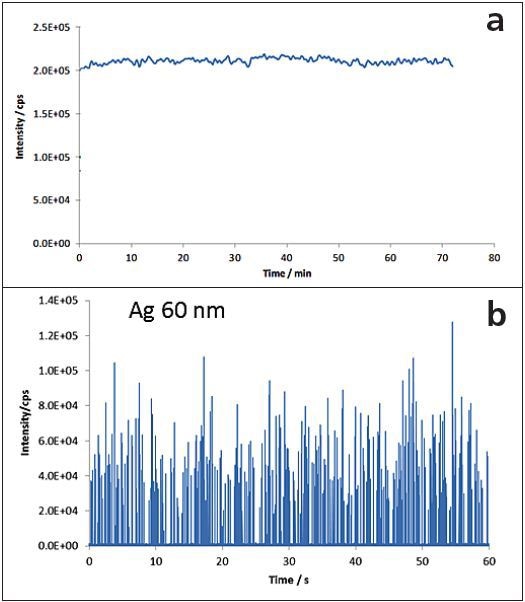
Figure 1. a) A continuous signal from measuring a dissolved analyte; b) A signal from measuring 60 nm silver nanoparticles.
In Figure 1a, a steady-state signal ensues from analyzing dissolved elements. When detecting single particles, the output is completely different, as shown for 60 nm silver particles in Figure 1b.
The way these data are acquired is important to gain a better insight into single particle analysis. One simple way to realize this is to assess and compare the procedures involved when particles and dissolved elements are determined.
Dissolved Element Analysis with ICP-MS
While measuring dissolved elements, aerosols penetrate the plasma and the droplets are ionized. The resulting ions enter the quadrupole to be analyzed by their mass to-charge ratios (m/z).
During each analysis, the quadrupole spends time measuring each m/z; this time is referred to as the dwell time. Following each dwell time measurement, the electronics are allowed to stabilize before the next measurement. This stabilization time is known as the settling time.
During analysis of dissolved elements, a steady-state signal is obtained (Figure 2a). However, the measurement is not continuous since no data is acquired during the settling time. This is an important factor when measuring nanoparticles (Figure 2b), which produce discreet signals.
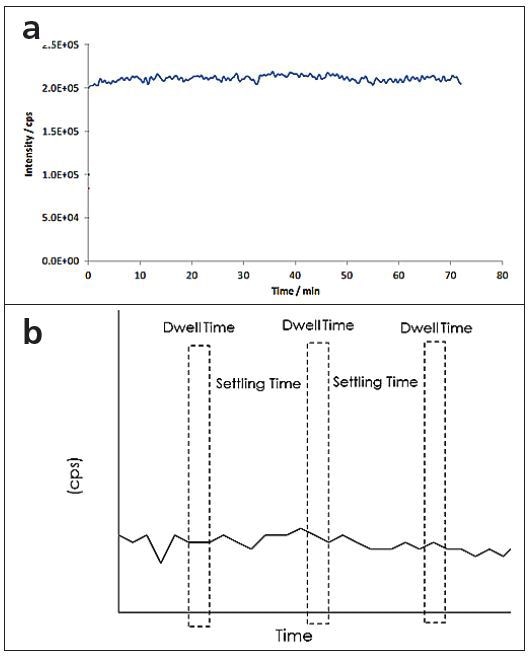
Figure 2. a) A continuous signal from measuring a dissolved element; b) A continuous signal, with the dwell and settling times overlaid – data is only collected during the dwell time.
Single Particle Analyses with ICP-MS
When particles enter the plasma, the droplets are desolvated, producing particles which are then ionized, creating a burst of ions (known as the ion cloud) which then enter into the quadrupole.
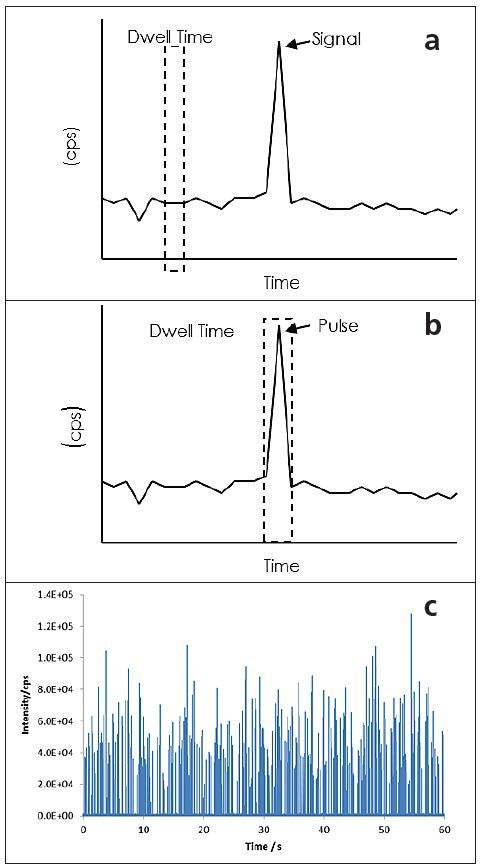
Figure 3. a) Signal from a single nanoparticle falling outside of the dwell time/measurement window, and, therefore, not detected; b) Signal from a single nanoparticle falling within the dwell time/measurement window, and, therefore, detected; c) Signals from multiple nanoparticles falling within dwell time/measurement windows and detected.
However, when traditional ICP-MS data collection is used for nanoparticle measurements, ion clouds from individual particles are not always detected. For instance, if the ion reaches the detector or travels into the quadrupole during the settling time, it is not possible to detect it.
This leads to incorrect counting efficiency. Figure 3a illustrates that an ion cloud from a particle will not be detected if it falls outside of the dwell-time window. If the ion cloud from a nanoparticle occurs within a dwell-time window, it will be detected, as shown in Figure 3b.
Figure 3c shows a typical output when performing nanoparticle analysis, where each spike represents the signal (or part of the signal) from a single nanoparticle. It is unknown how many particles are not detected due to settling time.
Timing Parameters of Single Particle ICP-MS
The timing parameters which are involved in ICP-MS analysis are shown in Figure 4. With traditional or dissolved analysis, the intensity and mass axes are important as the ensuing spectra are plots of m/z against intensity; the time axis is only important for transient signals, such as those resulting from chromatography or particles.
This speed at which the quadrupole can move from one mass to another is known as the ‘quadrupole scan speed’, which is important when multiple elements are determined in a transient signal.
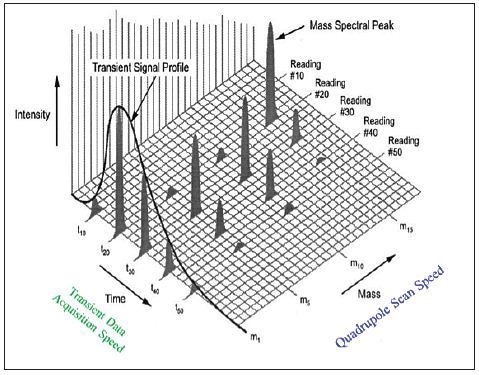
Figure 4. The timing parameters of ICP-MS analyses.
For Single Particle ICP-MS, transient data acquisition speed is of major importance. This component includes two parameters, namely settling time (time to change between masses) and dwell time (reading or acquisition time). For successful SP-ICP-MS analysis, it is vital to ensure that the ICP-MS obtains signals at a dwell time shorter than that of the particle transient time.
This prevents false signals produced from particle coincidence, partial particle integration, and aggregates or agglomerates. In other words, when both the dwell and settling times are shorter than the particle transient time, there is less possibility of missing a particle.
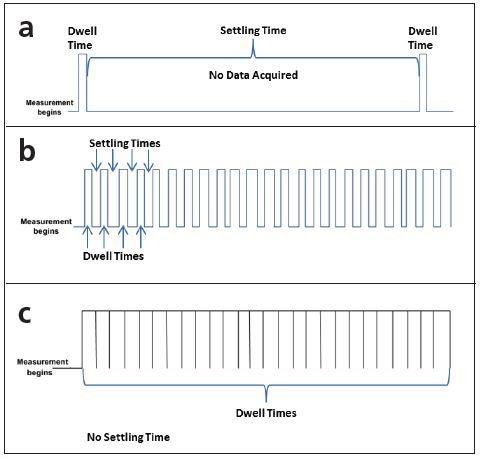
Figure 5. Effect of settling time and dwell time on ICP-MS measurements: a) Settling time is much longer than the dwell time; b) Settling time is equal to the dwell time; c) Settling time is eliminated.
Figure 5 shows the significance of settling time utilizing a fixed time window and a constant dwell time. To ensure proper SP-ICP-MS data acquisition, measurements without any settling time should be used (Figure 5c) combined with very short dwell time.
Multiple Measurements per Particle
As shown in Figure 4, it is crucial to achieve signal profiling for transient signal such as that of a nanoparticle. This could only be achieved if the ICP-MS used is capable of acquiring data at a dwell time that is shorter than the individual particle transient signal.
If such an operating condition is not met, two particles could be identified in a single dwell time window (Figure 6a), which results in a large signal response as if a single particle of a larger size has been identified.
In Figure 6b, only one particle is identified in the dwell time window and represents a desirable situation, on condition that fast continuous data acquisition is unavailable. The signal that ensues is half the size of Figure 6a.
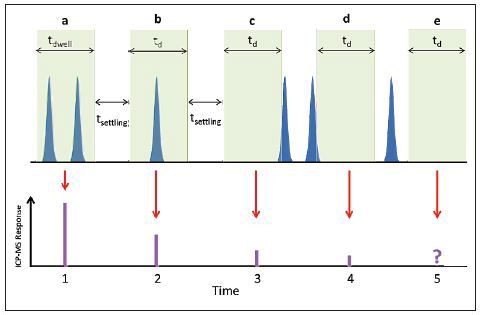
Figure 6. Effect of dwell and settling times on single nanoparticle measurements: a) Two particles detected; b) One particle detected; c) The leading edge of one particle detected; d) The trailing edge of one particle detected; e) No particles detected.
Figures 6c and 6d show undesirable situations where only a partial ion pulse from particles is identified. The resulting signals are small and lead to incorrect particle sizing, while Figure 6e shows the most undesirable situation, where the particle is not detected because it falls outside of the dwell time window leading to incorrect particle counting.
Precise SP-ICP-MS analysis is only achievable if the ICP-MS is capable of acquiring fast continuous (no settling time between readings) data at a dwell time that is shorter than an individual particle transient time. This is important since proper nanoparticle detection and quantitation is only achievable when peak area integration is used, which can only be accomplished when a minimum of six data points are acquired per particle.
Figure 7 illustrates the concept of acquiring multiple data points per particle, thus defining the peak. Since the duration of the ion cloud from the ionization of a single nanoparticle is 300-500 µs, dwell times less than 100 µs are required in order to obtain six data points per peak. As an example, assuming the duration of the ion cloud is 300 µs, a dwell time of 50 µs is required to obtain six data points to define the peak.
These examples underline the importance of fast, continuous data acquisition, where data is obtained continuously sans any settling time, thus guaranteeing precise particle counting. Fast continuous data acquisition also allows for multiple point measurements from a particle and hence prevents the possibilities that only part of the ion clouds from particles is identified or whether particles are missed.
Conclusion
Using ICP-MS for single particle measurement requires a different approach than analyzing dissolved elements. When analyzing single particles, the transient data acquisition speed is the most important parameter during data acquistion.
Continuous measurement helps in taking multiple readings for each particle ionization event, which leads to more precise determination of particle size. In the case of single particle analysis with ICP-MS, fast continuous data acquisition at dwell times less than or equal to 100 µs is vital to obtain accurate nanoparticle counting and sizing.

This information has been sourced, reviewed and adapted from materials provided by PerkinElmer Inc.
For more information on this source, please visit PerkinElmer Inc.